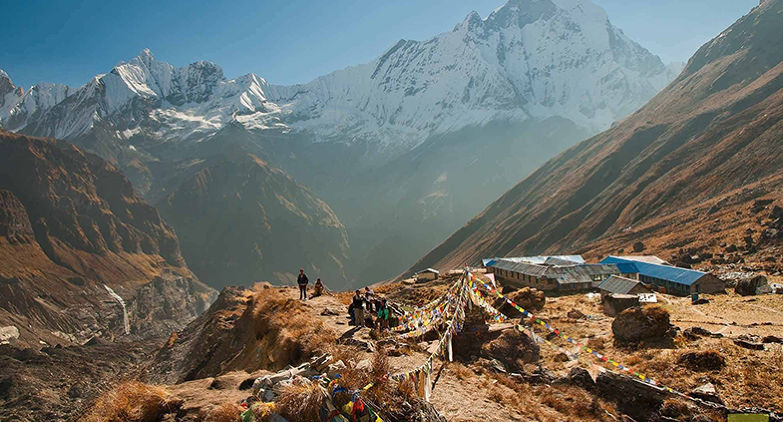The Annapurna Base Camp trek is not just a physical journey; it’s an opportunity to immerse yourself in the stunning natural beauty and rich culture of Nepal. With proper planning, preparation, and a respectful attitude towards nature and local communities, you can make the most of this remarkable adventure of a lifetime.
The allure of the Himalayas, with their towering peaks, awe-inspiring landscapes, and vibrant cultures, beckons adventurers from around the globe. Among the many treks that Nepal has to offer, the Annapurna Base Camp (ABC) trek stands as a captivating journey that promises both physical challenges and soul-stirring experiences. If you’re considering immersing yourself in the breathtaking beauty of the Annapurna Range, meticulous planning is key to ensuring a safe, enjoyable, and awe-inspiring adventure. In this guide, we’ll take you through the essential steps to plan your Annapurna Base Camp trek – from choosing the right time to trek and obtaining permits, to packing wisely and embracing the local culture. Lace up your trekking boots, for the journey of a lifetime awaits amidst the grandeur of the Himalayas.
Discovering the Trekkers’ Paradise:
Nestled in the heart of Nepal, the Annapurna Base Camp trek offers an expedition unlike any other. With its moderate difficulty level, this trek is accessible to both seasoned hikers and those new to the world of trekking. The journey to the base camp, located at an altitude of 4,130 meters (13,550 feet), weaves through a tapestry of landscapes – from lush rhododendron forests and quaint villages to majestic alpine meadows and glacial valleys. The pièce de résistance of the trek, of course, is the captivating view of the Annapurna Massif and its towering peaks, including the iconic Annapurna I, standing at 8,091 meters (26,545 feet).
Deciding on the Perfect Season:
Choosing the right time to embark on the Annapurna Base Camp trek is crucial. Nepal experiences two primary trekking seasons: the pre-monsoon (spring) and post-monsoon (autumn). Spring, from March to May, gifts trekkers with blooming rhododendrons, clear skies, and moderate temperatures. Autumn, spanning from September to November, offers crisp air, stunning visibility, and a vibrant landscape painted with the hues of autumn leaves. Both seasons have their unique charms, allowing you to select the time that resonates most with your preferences.
Navigating the Paperwork:
Before setting foot on the trail, it’s imperative to ensure you have the necessary permits. The Annapurna Base Camp trek requires two permits: the Annapurna Conservation Area Permit (ACAP) and the Trekkers’ Information Management System (TIMS) card. These permits not only facilitate your journey but also contribute to the preservation of the natural and cultural heritage of the region. You can obtain these permits in Kathmandu or Pokhara through authorized agencies or the Nepal Tourism Board.
Equipping Yourself for the Journey:
Packing for the Annapurna Base Camp trek necessitates a balance between being prepared and traveling light. Proper gear is essential to tackle the changing weather and altitude challenges. From sturdy trekking boots and moisture-wicking clothing to a warm down jacket and a comfortable backpack, each item you bring plays a role in ensuring your comfort and safety. Don’t forget to include essentials like a first aid kit, sunglasses, gloves, and a hat to shield you from the elements.
Cultivating Physical Preparedness:
Embarking on a trek of this magnitude demands physical readiness. Engage in regular cardiovascular exercises and strength training to build your endurance and stamina. The trek’s gradual ascent aids in acclimatization, but it’s vital to listen to your body and rest when needed. Acclimatization days at higher altitudes allow your body to adjust to the reduced oxygen levels, minimizing the risk of altitude sickness.
Crafting Your Itinerary:
The Annapurna Base Camp trek typically spans 7 to 12 days, depending on your chosen route and pace. Starting from Nayapul, the trail winds through enchanting villages like Ghorepani and Chhomrong, offering glimpses into the daily lives of the local communities. The trail to Annapurna Base Camp passes through Machapuchare Base Camp, a pristine alpine setting with awe-inspiring views. Customize your itinerary to match your fitness level and the time you have at hand, ensuring a balanced mix of trekking and rest.
Guidance and Cultural Immersion:
While the Annapurna Base Camp trek can be undertaken independently, the inclusion of a local guide and porter can add depth to your experience. A guide provides insights into the local culture, geography, and history, enhancing your understanding of the region. A porter can alleviate the physical strain of carrying heavy backpacks, enabling you to fully appreciate the beauty around you. Engaging with local communities and respecting their customs enriches your journey, fostering meaningful connections along the trail.
Dwelling and Dining Along the Trail:
Accommodation during the trek ranges from basic teahouses to more comfortable lodges, offering varying degrees of comfort. Meals provide sustenance and energy for your adventure, with options encompassing local and international dishes. While exploring the diverse flavors, remember to stay hydrated with clean water – using purification tablets or filters – to minimize the use of single-use plastic bottles.
Upholding Environmental Responsibility:
As you traverse through pristine landscapes, it’s imperative to uphold the principles of responsible trekking. Minimize your impact by adhering to the Leave No Trace principles: pack out all non-biodegradable waste, stay on designated trails, and avoid disturbing local flora and fauna. Respect the natural beauty and cultural heritage of the region, leaving it as untouched as possible for generations to come.
Hiring a Guide and Porter:
While the Annapurna Base Camp trek can be done independently, hiring a local guide and/or a porter can enhance your experience. A guide can provide valuable insights about the region, culture, and help navigate the trail. A porter can alleviate the burden of carrying heavy backpacks, allowing you to focus on the trek itself.
Conclusion:
The Annapurna Base Camp trek is an expedition that transcends physical boundaries, immersing you in the grandeur of nature and the warmth of local communities. Careful planning, adequate preparation, and a respectful attitude towards the environment and culture ensure a transformative journey. As you gaze upon the snow-clad peaks of the Annapurna Range, you’ll not only conquer the challenges of the trail but also forge lasting memories in the heart of the Himalayas.



